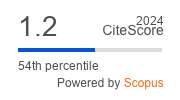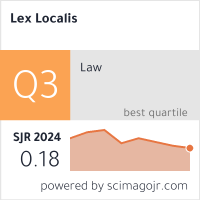Flowers vs Garbage Trucks: Which Type of Local Government Investment Has the Greatest Impact on Economic Growth?
DOI:
https://doi.org/10.52152/22.2.1-25(2024)Keywords:
fiscal multiplier, local government investment, fiscal multiplier of disaggregated investment expenditure, local projectionsAbstract
This article is an empirical study of the values the fiscal multipliers of different types of local government investment for 73 NUTS-3 sub-regions in Poland over the period from 2007 to 2021. The findings suggest that in the 1-2 years following the initial shock, the accumulated fiscal multipliers of investment expenditures are either insignificant or are significant but less than 1. Contrarily, during the 3-5 year period, the accumulated fiscal multipliers of total investment expenditures and expenditures on road construction show a significant increase, surpassing 1.5. Meanwhile, the fiscal multiplier of investments funded by EU structural funds can reach as high as 3.0.
References
Acconcia, A., Corsetti, G., & Simonelli, S. (2014). Mafia and public spending: Evidence on the fiscal multiplier from a quasi-experiment. American Economic Review, 104(7), 2185-2209. doi: 10.1257/aer.104.7.2185
Alichi, A., Shibata, I., & Tanyeri, K. (2019). Fiscal policy multipliers in small states. Economía, 21(2), 69-114. Retrieved from https://www.jstor.org/stable/27164731
Amendola, A., Di Serio, M., Fragetta, M., & Melina, G. (2020). The euro-area government spending multiplier at the effective lower bound. IMF Working Papers, 19(133), 1-32. doi: 10.5089/9781498314947.001
Aschauer, D. A. (1989). Is public expenditure productive?. Journal of Monetary Economics, 23(2), 177-200. doi: 10.1016/0304-3932(89)90047-0
Auerbach, A. J., & Gorodnichenko, Y. (2012). Measuring the output responses to fiscal policy. American Economic Journal: Economic Policy, 4(2), 1-27. doi: 10.1257/pol.4.2.1
Auerbach, A. J., & Gorodnichenko, Y. (2013). Output spillovers from fiscal policy. American Economic Review, 103(3), 141-146. doi: 10.1257/aer.103.3.141
Auerbach, A. J., & Gorodnichenko, Y. (2017). Fiscal stimulus and fiscal sustainability. National Bureau of Economic Research, (23789). doi: 10.3386/w23789
Auerbach, A., Gorodnichenko, Y., & Murphy, D. (2019). Local fiscal multipliers and fiscal spillovers in the USA. IMF Economic Review, 68, 195-229. doi: 10.1057/s41308-019-00102-3
Barro, R. J., & Redlick, C. J. (2011). Macroeconomic effects from government purchases and taxes. The Quarterly Journal of Economics, 126(1), 51-102. doi: 10.1093/qje/qjq002.
Baxter, M., & King, R. G. (1993). Fiscal Policy in general equilibrium. The American Economic Review, 83(3), 315-334.
Blanchard, O., & Perotti, R. (2002). An empirical characterization of the dynamic effects of changes in government spending and taxes on output. The Quarterly Journal of Economics, 117(4), 1329-1368. doi: 10.1162/003355302320935043
Boehm, C. E. (2020). Government consumption and investment: Does the composition of purchases affect the multiplier?. Journal of Monetary Economics, 115, 80-93. doi: 10.1016/j.jmoneco.2019.05.003
Bom, P. R. D., & Ligthart, J. E. (2013) What have we learned from three decades of research on the productivity of public capital?. Journal of Economic Surveys, 28(5), 889-916. doi: 10.1111/joes.12037
Brückner, M., & Tuladhar, A. (2013). Local government spending multipliers and financial distress: Evidence from Japanese prefectures. The Economic Journal, 124(581), 1279-1316. doi: 10.1111/ecoj.12076
Burriel, P., De Castro, F., Garrote, D., Gordo, E., Paredes, J., & Pérez, J. J. (2010). Fiscal policy shocks in the euro area and the US: An empirical assessment. Fiscal Studies, 31(2), 251-285. doi: 10.1111/j.1475-5890.2010.00114.x
Chodorow-Reich, G. (2019). Geographic cross-sectional fiscal spending multipliers: What have we learned?. American Economic Journal: Economic Policy, 11(2), 1-34. doi: 10.1257/pol.20160465
Christiano, L., Eichenbaum, M., & Rebelo, S. (2011) When is the government spending multiplier large?. Journal of Political Economy, 119(1), 78-121. doi: 10.1086/659312
Czudec, A., & Kata, R. (2016). Processes of regional convergence in Poland in the context of the use of European Union Funds, Lex Localis-Journal of Local Self-Government, 14(4), 715-737. doi: 10.4335/14.4.715-737(2016)
Dall'Erba, S., & Fang, F. (2017). Meta-analysis of the impact of European Union Structural Funds on regional growth. Regional Studies, 51(6), 822-832. doi: 10.1080/00343404.2015.1100285
Deleidi, M. (2021). Quantifying multipliers in Italy: Does fiscal policy composition matter?. Oxford Economic Papers, 74(2), 359-381. doi: 10.1093/oep/gpab028
Deleidi, M., Iafrate, F., & Levrero, E. S. (2023). Government investment fiscal multipliers: Evidence from Euro-area countries. Macroeconomic Dynamics, 27(2), 1-19. doi: 10.1017/s1365100521000419
Deleidi, M., Romaniello, D., & Tosi, F. (2021). Quantifying fiscal multipliers in Italy: A Panel SVAR analysis using regional data. Papers in Regional Science, 100(5), 1158-1177. doi: 10.1111/pirs.12620
Filipiak, B. Z., & Kluza, K. (2022). Political business cycle in local governments in transition and developing economies. Literature review and empirical study for Poland. Lex Localis-Journal of Local Self-Government, 20(4), 1057-1082. doi: 10.4335/20.4.1057-1082(2022)
Ganelli, G., & Tervala, J. (2020). Welfare multiplier of public investment. IMF Economic Review, 68(2), 390-420. doi: 10.1057/s41308-020-00111-7
Gechert, S. & Will, H. (2012). Fiscal Multipliers: A Meta Regression Analysis. IMK Working Paper, (97). Retrieved from https://www.econstor.eu/handle/10419/105964
Gordon, R. J. (2017). The rise and fall of American growth: The U.S. standard of living since the Civil War. Princeton, NJ: Princeton University Press.
Gupta, S., Kangur, A., Papageorgiou, C., & Wane, A. (2014). Efficiency-adjusted public capital and growth. World Development, 57, 164-178. doi: 10.1016/j.worlddev.2013.11.012
Hamilton, J. D. (2018). Why you should never use the Hodrick-Prescott filter. Review of Economics and Statistics, 100(5), 831-843. doi: 10.1162/rest_a_00706
Hollmayr, J., & Kuckuck, J. (2018). Fiscal multipliers of central, state and local government and of the social security funds in Germany: Evidence of a SVAR. Bundesbank Discussion Paper, (28). Retrieved from https://www.econstor.eu/handle/10419/182021
Ilzetzki, E., Mendoza, E. G., & Végh, C. A. (2013). How big (small?) are fiscal multipliers?. Journal of Monetary Economics, 60(2), 239-254. doi: 10.1016/j.jmoneco.2012.10.011
International Monetary Fund. Research Dept. (2014). World Economic Outlook, October 2014: Legacies, clouds, uncertainties. International Monetary Fund. doi: 10.5089/9781484372265.081
Jesus-Silva N., & Ribeiro, D. (2019). The influence of the European H2020 program on the development of regions: The multiplier impact of EU funding in the regions under horizon 2020 in NUT III-North. Lex Localis-Journal of Local Self-Government, 17(3), 853-871. doi: 10.4335/17.3.853-871(2019)
Jordà, Ò. (2005). Estimation and inference of impulse responses by local projections. American Economic Review, 95(1), 161-182. doi: 10.1257/0002828053828518
Kameda, T., Namba, R., & Tsuruga, T. (2021). Decomposing local fiscal multipliers: Evidence from Japan. Japan and the World Economy, 57, 1-17. doi: 10.1016/j.japwor.2021.101053
Masten, I., & Grdović, G. A. (2019). Macroeconomic effects of public investment in South-East Europe. Journal of Policy Modeling, 41(6), 1179-1194. doi: 10.1016/j.jpolmod.2019.05.005
Nakamura, E., & Steinsson, J. (2014). Fiscal stimulus in a monetary union: Evidence from US regions. American Economic Review, 104(3), 753-792. doi: 10.1257/aer.104.3.753
Panizza, U., & Presbitero, A. F. (2013). Public debt and economic growth in advanced economies: A survey. Swiss Journal of Economics and Statistics, 149, 175-204. doi: 10.1007/BF03399388
Pellegrini, G., Terribile, F., Tarola, O., Muccigrosso, T., & Busillo, F. (2013). Measuring the effects of European regional policy on economic growth: A regression discontinuity approach. Papers in Regional Science, 92(1), 217-233. doi: 10.1111/j.1435-5957.2012.00459.x
Perez-Montiel, J., & Manera, C. (2021). Government public infrastructure investment and economic performance in Spain (1980-2016). Applied Economic Analysis, 30(90), 229-247. doi: 10.1108/aea-03-2021-0077
Petrović, P., Arsić, M., & Nojković, A. (2021). Increasing public investment can be an effective policy in bad times: Evidence from emerging EU economies. Economic Modelling, 94, 580-597. doi: 10.1016/j.econmod.2020.02.004
Ramey, V. A. (2011). Can government purchases stimulate the economy?. Journal of Economic Literature, 49(3), 673-685. doi: 10.1257/jel.49.3.673
Ramey, V. A. (2021). The macroeconomic consequences of infrastructure investment. In E. L. Glaeser, & J. M. Poterba (Eds.), Economic Analysis and Infrastructure Investment (pp. 219-268). Chicago, IL: University of Chicago Press.
Ramey, V. A., & Zubairy, S. (2018). Government spending multipliers in good times and in bad: Evidence from US historical data. Journal of Political Economy, 126(2), 850-901. doi: 10.1086/696277
Romp, W. E., & De Haan, J. (2007). Public capital and economic growth: A critical survey. Perspektiven Der Wirtschaftspolitik, 8(S1), 6-52. doi: 10.1111/j.1468-2516.2007.00242.x
Saccone, D., Posta, P. D., Marelli, E., & Signorelli, M. (2022). Public investment multipliers by functions of government: An empirical analysis for European countries. Structural Change and Economic Dynamics, 60, 531-545. doi: 10.1016/j.strueco.2022.01.006
Sekuła, A. (2015). General grants and development-a relationship without a future? The effects of the structure of general grants on the development of local government units in Poland. Lex Localis-Journal of Local Self-Government, 13(4), 915-932. doi: 10.4335/13.3.915-932(2015)
Sheremirov, V., & Spirovska, S. (2022). Fiscal multipliers in advanced and developing countries: Evidence from military spending. Journal of Public Economics, 208, 1-25. doi: 10.1016/j.jpubeco.2022.104631
Shoag, D. (2016). The impact of government spending shocks: Evidence on the multiplier from state pension plan returns. unpublished paper, Harvard University Working Paper. Retrieved from https://citeseerx.ist.psu.edu/document?repid=rep1&type=pdf&doi=e705f0ba8c032fd365c0cb85c38da4317d14ddb2
Downloads
Published
Issue
Section
License
Copyright (c) 2024 Lex localis - Journal of Local Self-Government

This work is licensed under a Creative Commons Attribution-NonCommercial-NoDerivatives 4.0 International License.








